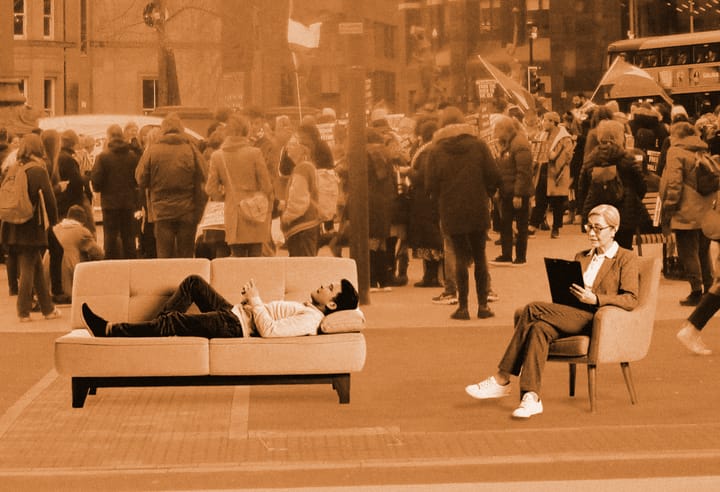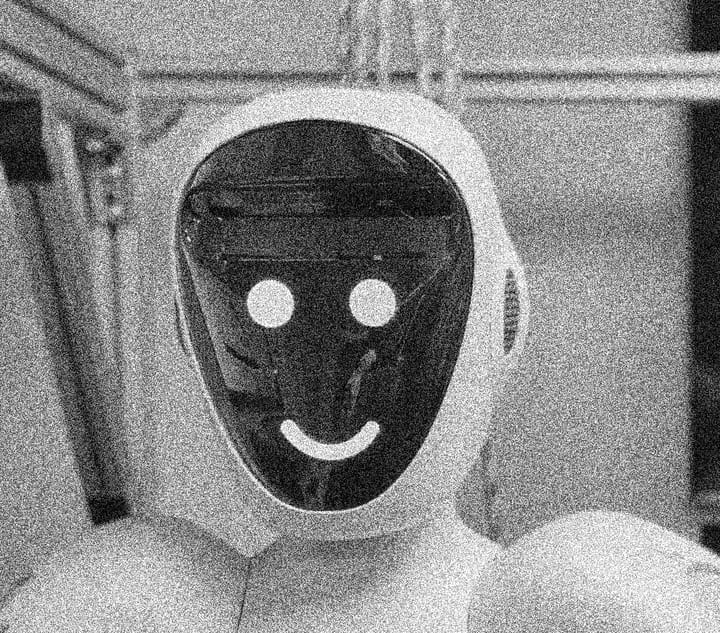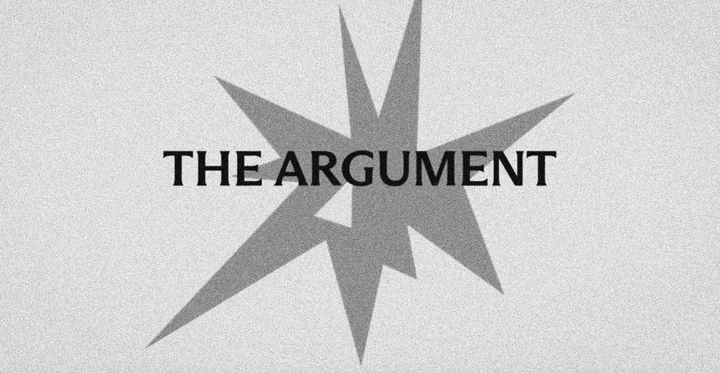A Report on Neoliberal Psychology, Part Two
On the difficulties that arise in any attempt to trace social character to neoliberalism.

Part One of A Report on Neoliberal Psychology is available here.
Our understanding of human nature, like that of non-human nature, always reflects both material and ideological tendencies in society. By focusing on a new form of anxiety, Curran and HIll are convincingly highlighting something objective about psychological life today: the pressures of self-preservation in capitalism are making everyone, including young people and children, anxious to the point of sickness. Many straightforward social objectives appear unsolvable, and relationships which might have provided previous generations with a semblance of non-alienated experience are today being co-opted by technologies for profit, often transforming them into another source of interpersonal angst.
One problem is that the construal of neoliberalism as a “value system,” while supposing itself to begin from materialist grounds, unintentionally accords formative causal primacy to rather superficial statements about culture and ideology. This sidesteps an analysis of the deeper mechanisms of integration and internalization that reduce our inner lives to moments of objective processes.
While the neoliberal doxa about history, markets, etc. has lost much of its hegemony in recent years, its material-economic compulsions are as strong as ever. This can only mean that our behavior, even when the cultural mediations of value might be weakened, remains in a strict relationship to social demands. Our psyches are intertwined with the social pressures of material reproduction in more ways than ideology can capture. A deeper, related problem is that the analysis based in meritocratic cultural values risks making psychological mechanisms of identification irrelevant. It might be easy for someone to argue that, objectively speaking, psychology is not needed to explain the social anxieties that Curran and Hill illustrate. Capitalist profits depend upon exploitation, and exploitation requires the maintenance of an immense power differential between employer and individual worker. This means that most workers are expendable, and many respond by thinking first and foremost about how to secure their own position, which often prevents workers from thinking of ways they could benefit from organizing. In the context of mutual alienation and competition, the symptoms that Curran and Hill outline—manic ambition, paranoid social relations, and a collapsed distinction between personal worth and professional achievement—do not need to be psychologically forced upon us. They are internal to the very social relations of capitalist society as a mode of production and a particular class relation.
It is fascinating that these objective, sociological considerations help clarify the opposite pole of the analysis. That is, they help show why the description of perfectionism sounds so psychologically superficial—“a sense of self overwhelmed by pathological worry and a fear of negative social evaluation, characterized by a focus on deficiencies, and sensitive to criticism and failure,” etc. These psychological traits could be tied to any number of different and even conflicting symptoms, defense mechanisms, and personality types.
All this goes to show that while values certainly play on both conscious and unconscious levels of psychic life, we are dealing here with a nexus of base material compulsions—precisely those elements which mental life must come to terms with in its development from our earliest years. Values are reflections of mechanisms of internalization and integration—for instance, social paranoia and mania, which are themselves responses to dwindling material prospects. Even for those who manage to survive in relatively higher class strata, the refinement of perfectionist habits are necessities dictated not by ethos, but survival.
This critique is a negative outline of a more psychodynamically informed social psychology—one that traces a closer relationship between psychoanalytic categories of psychic development and the various forms of repression that prepare us for the hellscape of our adulthood in neoliberal capitalism—even as the one is not reducible to the other.
In fact, what the Curran and Hill study gestures toward is a new modality of upbringing-as-destruction. The characteristic forms of this upbringing ought to be brought into constellation with insights into infantile sexuality, regression, and the significance of very early, even pre-Oedipal stages on how we will later navigate reality. Such a study would take us far beyond the present critique of a self-destructive “value system.” But for now it suffices to conclude with some reflections on how social psychology today can remain true to the preponderance of objective social facts without falling into trite or overly general psychological description.
The greatest difficulty for social psychology always concerns the theorization of how social demands are internalized—how they become anchored in the individual’s sense of the world and his or her desires. The paradox is that it is precisely at this point, when we ought to be outlining a more nuanced psychodynamic explanation, that we are forced to turn back to the details of our social theory of capitalism. It is on the grounds of capitalist profit making, just as much as psychology, that the source of conflicting theorizations will be found. The dialectic of sociology and psychology once again reminds us how difficult it is to isolate the one from the other. Only when we understand more clearly the logic of contemporary society will we be prepared to outline how the predominant psychic structure amounts to a form of adaptation to it. By doing so, we will be able to recognize the true causal structure of psychological trauma and the defenses it engenders in the individual.
Perhaps even more paradoxically, one of the hidden powers of depth-analytic accounts is that, precisely by attending to the deepest structures of the individual and their history, they are able to bring into stark relief the fundamental facts of contemporary social reality. By accurately registering our deepest forms of internalization, psychology becomes a key to insights about our social world which remain obscure to objective sociological accounts—namely, that advanced society is today unambiguously a force of barbarism, and that life within this society, which has a greater potential than ever before to be released from the principle of subsistence, remains structured on the individual level by repression, domination, and the blind terror of self-preservation. Because capitalism as a form of social reproduction constantly reproduces inescapable conditions of base need, precisely that science which illuminates the primitive within all of us—psychoanalysis—becomes integral to the critical understanding of social life.
Attempts to develop a theory of a new psychic structure have to grapple with the sociological fact that the maintenance and intensification of blind, primitive terror underlies the forms of negotiation today that would otherwise seem bizarre. The maintenance and reproduction of capitalism is inseparable from the destruction of the individuals who make it up.
Or, as Marx put it,
In proportion as capital accumulates, the lot of the labourer, be his payment high or low, must grow worse…establishing an accumulation of misery, corresponding with accumulation of capital. The accumulation of wealth at one pole is, therefore, at the same time accumulation of misery, agony of toil slavery, ignorance, brutality, mental degradation, at the opposite pole.
This dynamic has always existed—it defines capitalism. The question for contemporary social-psychology is how to locate the latest mechanisms, and to question whether or not there has been a break with the character structures of the past.
Heightened anxiety about the judgments of others might be a superficial expression of psychic damage the correct interpretation of which requires not so much a desire to see what is new. The rise of manifestly authoritarian elements require a return to the late capitalist character structure analyzed in the midcentury studies undertaken by the exiled members of the Frankfurt School, not to mention Freud’s work on narcissism and the death drive and the social psychology of Wilhelm Reich.
How might we determine whether a new character structure has emerged, and how do we describe it psychoanalytically? What are the most significant contemporary social and cultural mediations of the psychological dynamics that generate, stabilize, and perpetuate the symptoms of the neoliberal character? The new character is characterized by increased anxiety; heightened paranoia about the opinions of others; a weaker, more rigid, and less stable sense of self; decreased autonomy; increased dependence on the constant reception of good inputs from others; new, technology-mediated dependency relationships; and a general tendency to feel inadequate or generally bad. But these are not the contours of a “neoliberal” structure composed of traits most likely to show up in millennials. Rather, they are the very same characteristics that underpinned the widely repudiated midcentury analysis of the “authoritarian personality”.
The authoritarian character type—a product of late, post-liberal capitalism—was likewise typified by a rigid or “weak” ego and a corresponding conformity-inducing anxiety. Analogous with the new studies, this characterization was motivated by an attempt to distinguish mid-century characteristics from those of previous generations. The most important point of distinction between the new type of patient, described by thinkers like Christopher Lasch, and the old type of patient, reported by Freud and his colleagues, was that the former’s sense of self was not integrated enough to achieve the repression-symptoms of the neurotic.
The former was a product of a totally administered, corporate capitalism that had successfully integrated all spheres of life to its goals, including the most formative institutions: the family, education, religion, and culture. Lacking all autonomy, the late capitalist self was too underdeveloped to come into conflict with reality in the way of the fin-de-siecle individual. Today these changes appear as relevant as ever, but it is important to recognize that this type of character structure is not a product of the 80’s and 90’s, but of a phase of capitalism that stretches from the early 20th century to its terminal phase in neoliberalism. No longer capable of dealing with the demands of self-determination in the face of the overwhelming power of social institutions, the authoritarian or “non-democratic” character of the midcentury was rigid in thinking, paranoid, given to uncritical worship of authority as such, and displayed an aversion to the free play of the imagination—the same characteristics that provide the relief of contemporary conformism.
In the meantime, a whole history of psychoanalytic theory has developed. Narcissism and generalized anxiety—two of the major factors outlined in contemporary descriptions—point to the relevance of trauma-dissociation models over the repression-neurosis model of the Freudian bourgeois individual. Repression is a higher-order defense. It depends on a relatively more-integrated, developed self. Likewise, discussions of pre-Oedipal forms of projective identification point to a self that manically acts out parts that have been split off. While a vanishing mediator here might be found in Anna Freud’s work on the defenses, the early studies of the Institute for Social Research are interesting for the way they register these changes without abandoning the Freudian framework. It is equally important to recognize the invaluable contributions of the object relations tradition for understanding contemporary political psychology.
All this is to say that the discourse of “perfectionism” and “neoliberal personality” are new costumes for a character structure that is by no means new, not so much a differentia specifica as a more unambiguous and ubiquitous expression of mechanisms of identification and adaptation that have a long history. An adequate social psychology must return to its repressed roots as opposed to casting them aside for topical but superficial descriptions, which often fall flat in both sociological and psychological terms. Freud often compared psychoanalysis to archaeology. It was a metaphor that, while construing mental life in spatial terms, nevertheless captured something of the “timelessness” of the unconscious, the way the primitive stays with us. This factor remains its essential value for the analysis of social life in the most advanced society in history.
■
Elia Tommaso is a painter who lives mostly in the past.



